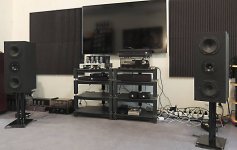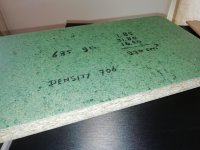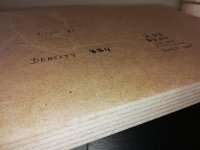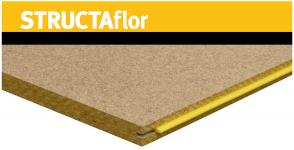My son is also mentally ill (the "S" decease) and if you have been there, you know what havoc that can play.
i am sorry to hear that, i hope he will get well soon
Joe,
Sorry to hear about the water damage - hope you can get it fixed soon.
Also my thoughts and best wishes regarding your son's illness - may you all as a family find the strength to cope with his condition, and hope it gets better with time.
Regarding cabinets - I am yet to start building mine. On another thread there's a discussion about benefits of bracing with better damping - my understanding is that MDF is better damped vs ply, but in the larger scheme of things, any real benefits in using MDF bracing vs ply?
I would have also liked to try out CLD panels, but they are not easy to implement. Easier for me would be to go for a sandwich layer e.g. 1/2 ply + 1/2 chipboard, or 1/2 ply + 1/2 MDF - that would probably result in dissimilar resonances - but again not sure how much of a real improvement it will be.
For hard and dense, I am thinking marine ply. All the layers are made of a hardwood available in these parts of the world (South Asia and South-East Asia). These ply boards are tougher and much heavier vs "standard" ply. The splinters can be quite nasty too!
Sorry to hear about the water damage - hope you can get it fixed soon.
Also my thoughts and best wishes regarding your son's illness - may you all as a family find the strength to cope with his condition, and hope it gets better with time.
Regarding cabinets - I am yet to start building mine. On another thread there's a discussion about benefits of bracing with better damping - my understanding is that MDF is better damped vs ply, but in the larger scheme of things, any real benefits in using MDF bracing vs ply?
I would have also liked to try out CLD panels, but they are not easy to implement. Easier for me would be to go for a sandwich layer e.g. 1/2 ply + 1/2 chipboard, or 1/2 ply + 1/2 MDF - that would probably result in dissimilar resonances - but again not sure how much of a real improvement it will be.
For hard and dense, I am thinking marine ply. All the layers are made of a hardwood available in these parts of the world (South Asia and South-East Asia). These ply boards are tougher and much heavier vs "standard" ply. The splinters can be quite nasty too!
Don't get obsessed over the acoustic properties of different materials. Sandwich layers are good, but again, don't get obsessed about it. I tend to choose the (outside) material by the looks (and my workshop possibilities). If SWMBO wants black MDF, use it. If she wants pink ceramic tiles, use it (and post some photos so we can have a laugh).
What you SHOULD get obsessed about is bracing. Use as much as you can, and your box will be fine regarding its acoustics (or the absence of acoustics).
What you SHOULD get obsessed about is bracing. Use as much as you can, and your box will be fine regarding its acoustics (or the absence of acoustics).
If I shorten the depth of the box to 13" to correct the internal volume (using 3/4" BB ply all around) does the middle brace location need to be adjusted? Probably a non-issue but as long as I'm obsessing I might as well obsess.
...my understanding is that MDF is better damped vs ply
A myth. MDF is fairly isotropic, in plywood every transition from one ply to the next adds damping. More plies, generally, the better. In India getting really good ply might be an issue (like in Oz — but they do seem to have a good supply of bamboo plywood), so making your own “frankenstien" ply might be a good way forward. A 10-ton press or vaccuum bag would be useful to hold the panels together while they cure.
I would have also liked to try out CLD panels, but they are not easy to implement.
I have concluded that constrained layers, while when done well are very effective, that it is an over the top approach and unnecessary to build a good box.
dave
(using 3/4" BB ply all around)
keep in mind that real BB is rarely 3/4” (19.1mm), but a nominal 18m (often called 3/4”, even here where we are mostly metric). Take your calipers and measure the material thickness before concluding exact dimensions.
I would not decrease the box depth but use the extra volume to improve the internal bracing.
If Joe approves i might do a drawing of the Elsinore as i would tart it up.
dave
keep in mind that real BB is rarely 3/4” (19.1mm), but a nominal 18m (often called 3/4”, even here where we are mostly metric). Take your calipers and measure the material thickness before concluding exact dimensions.
I would not decrease the box depth but use the extra volume to improve the internal bracing.
If Joe approves i might do a drawing of the Elsinore as i would tart it up.
dave
I'd be interested in seeing what you tart up if its ok with Joe. It would be nice to have an option with 3/4" or 18mm material.
Went looking for the plans: found this
I wonder how many have been done… the Frugel-Horn Mk3 is well into the thousands of builds.
dave
Arguably The World's Largest Online Speaker Project
I wonder how many have been done… the Frugel-Horn Mk3 is well into the thousands of builds.
dave
Ordered up the x-over components.. what a royal pain in the )*&^!
Pretty sure I was able to track every thing down, except for a ferrite core for L5, wound up going foil air core (I know, but after two days, I figured just get her done. Was that a mistake (aside from cost)?
Aside from a few misc things I have to get on track with the material being used...
The BB thread is perfectly timed!
Before I go that direction, a purely theoretical internal dampening question...
Without turning this into a debate on whether the product is snake oil or not, what if any benefit would there be with a lining product that is said to "provided a 23db reduction at 40 Hz" ?
I'm sure there is a reduction at other frequency, but I'm unable to find any data on the site....
An (shortened) statement found at the site says,
Being as thin as it is, I imagine attaching this some what loosely and directly to bare wood inside the box, and than may be a spray type of contact cement on the insulation and outer portion should work...
As the box in real life would not be more dampened, but only act like it is, would there be a benefit ? How about negatives ?
Glenn
Pretty sure I was able to track every thing down, except for a ferrite core for L5, wound up going foil air core (I know, but after two days, I figured just get her done. Was that a mistake (aside from cost)?
Aside from a few misc things I have to get on track with the material being used...
The BB thread is perfectly timed!
Before I go that direction, a purely theoretical internal dampening question...
Without turning this into a debate on whether the product is snake oil or not, what if any benefit would there be with a lining product that is said to "provided a 23db reduction at 40 Hz" ?
I'm sure there is a reduction at other frequency, but I'm unable to find any data on the site....
An (shortened) statement found at the site says,
After seeing the advert in youtube a few weeks back, I was intrigued. From the videos there is clearly a reduction in sound...It becomes an airtight membrane of extreme mass and flexibility... It damps the walls, ceiling, and floor by lowering the natural resonance of the structure. Acoustical energy intersects Blok16 material and in turn, it excites the material by vibrating it internally. Since the material is a visco-elastic polymer, it dissipates the acoustical energy efficiently within its own mass and reduces the sound transmission to the opposite side of the wall...
Being as thin as it is, I imagine attaching this some what loosely and directly to bare wood inside the box, and than may be a spray type of contact cement on the insulation and outer portion should work...
As the box in real life would not be more dampened, but only act like it is, would there be a benefit ? How about negatives ?
Glenn
You can certainly buy good quality ply in Australia .Hoop pine ply is commonly available and is excellent.At 600kg /cubic metre it is not quite as dense as baltic birch ply [680kg] but is far more dense and free of knots than the imported plundered rainforest stuff.
Hoop pine ply is commonly available and is excellent.
It doesn’t seem to be available all over. I’ve done special miniOnken drawings for its 17mm thickness. The FH3 flat-paks that were made (near Melbourne) used hoop pine.
dave
@Joe
regarding hamlet, i find this image on google and just realize that this is just small version of elsinore. my intention to use hamlet as center by positioning it on horizontal seems will have issue. am i correct? or is it possible to lay hamlet horizontally?
regarding hamlet, i find this image on google and just realize that this is just small version of elsinore. my intention to use hamlet as center by positioning it on horizontal seems will have issue. am i correct? or is it possible to lay hamlet horizontally?
Attachments
Expensive Birch ply is not necessary at all!
In my opinion (and long experience building enclosures), if you want to cut cost and get results at least as good as baltic birch ply enclosures:
- take what we call here 18 mm thick waterproof floor sheets of chipboard (see picture) for the enclosure less baffle; it is about three to four times cheaper than low grade BB, has density comparable with BB (about 700). This stuff has very hard pressed surfaces to withstand wear when used as floor. You can also apply screws into the crosscut sides (try that with MDF....);
- compose your own baffle by making a sandwich of 4 mm thick MDF sheets; this way you can make your preferred thickness. This MDF sandwich sheet has a density of almost 900 compared with some 600 of a normal MDF sheet and is very stiff!!
For the enclosure apply enough bracing, and you'll have a cost effective and very high quality enclosure for a fraction of what a BB enclosure would cost.
In my opinion (and long experience building enclosures), if you want to cut cost and get results at least as good as baltic birch ply enclosures:
- take what we call here 18 mm thick waterproof floor sheets of chipboard (see picture) for the enclosure less baffle; it is about three to four times cheaper than low grade BB, has density comparable with BB (about 700). This stuff has very hard pressed surfaces to withstand wear when used as floor. You can also apply screws into the crosscut sides (try that with MDF....);
- compose your own baffle by making a sandwich of 4 mm thick MDF sheets; this way you can make your preferred thickness. This MDF sandwich sheet has a density of almost 900 compared with some 600 of a normal MDF sheet and is very stiff!!
For the enclosure apply enough bracing, and you'll have a cost effective and very high quality enclosure for a fraction of what a BB enclosure would cost.
Attachments
@Joe
regarding hamlet, i find this image on google and just realize that this is just small version of elsinore. my intention to use hamlet as center by positioning it on horizontal seems will have issue. am i correct? or is it possible to lay hamlet horizontally?
After finishing my Els, depending on how it went, I was going to build a Hamlet for a horizontal center but never considered if it was appropriate to lay on its side. Will be interested in hearing the answer.
my intention to use hamlet as center by positioning it on horizontal seems will have issue. am i correct?
Sideways MTMs. while popular for centres, do not work well. It should to be oriented vertically. For those with spec issues, a simple MT would be best.
dave
...has density comparable with BB (about 700)...
Density is mostly irrelevant. Less dense with the same stiffness is better. Partical board/chipboard has been shown to work better than MDF, but “falls apart” easier.
I started out my speaker building with loots of K3 chipboard. Most memorable was when we dropped 5 sheets out of the back of the pickup into the middle of a major intersection n Calgary. I will not use the stuff anymore.
dave
For you maybe, not for me. For baffles I prefer mass and stiffness.Density is mostly irrelevant. Less dense with the same stiffness is better.
Not the floor sheet waterproof variety unless you are clumsy with woodworking.Partical board/chipboard has been shown to work better than MDF, but “falls apart” easier.
No idea what K3 chipboard stands for.I started out my speaker building with loots of K3 chipboard. Most memorable was when we dropped 5 sheets out of the back of the pickup into the middle of a major intersection n Calgary. I will not use the stuff anymore.
Like MDF, chipboard comes in a variety of qualities with respect to density and water resistancy.
Like said before by others, when the enclosure has sufficient bracing, and the material is applied properly, it just does not make a noticeable difference when using chipboard, MDF or ply. All subjective statements are just that....subjective.
I'd say that a major factor in choosing the material is cosmetic: the way you want to finish the loudspeaker.
@Joe
regarding hamlet, i find this image on google and just realize that this is just small version of elsinore. my intention to use hamlet as center by positioning it on horizontal seems will have issue. am i correct? or is it possible to lay hamlet horizontally?
Actually, you have it right, it can be used as both. That indeed was the idea from the beginning. It can be used in three different ways, 1) as a smaller stereo pair, 2) as additional speakers if going multi-channel and 3) use as a single speaker laterally for centre channel, maybe (?) put the screen on top of it.
[I just figured out something useful from this post. When the photo above is uploaded as an attachment and viewed, then right-click on it and get the uploaded image location url and use
- Home
- Loudspeakers
- Multi-Way
- The "Elsinore Project" Thread



